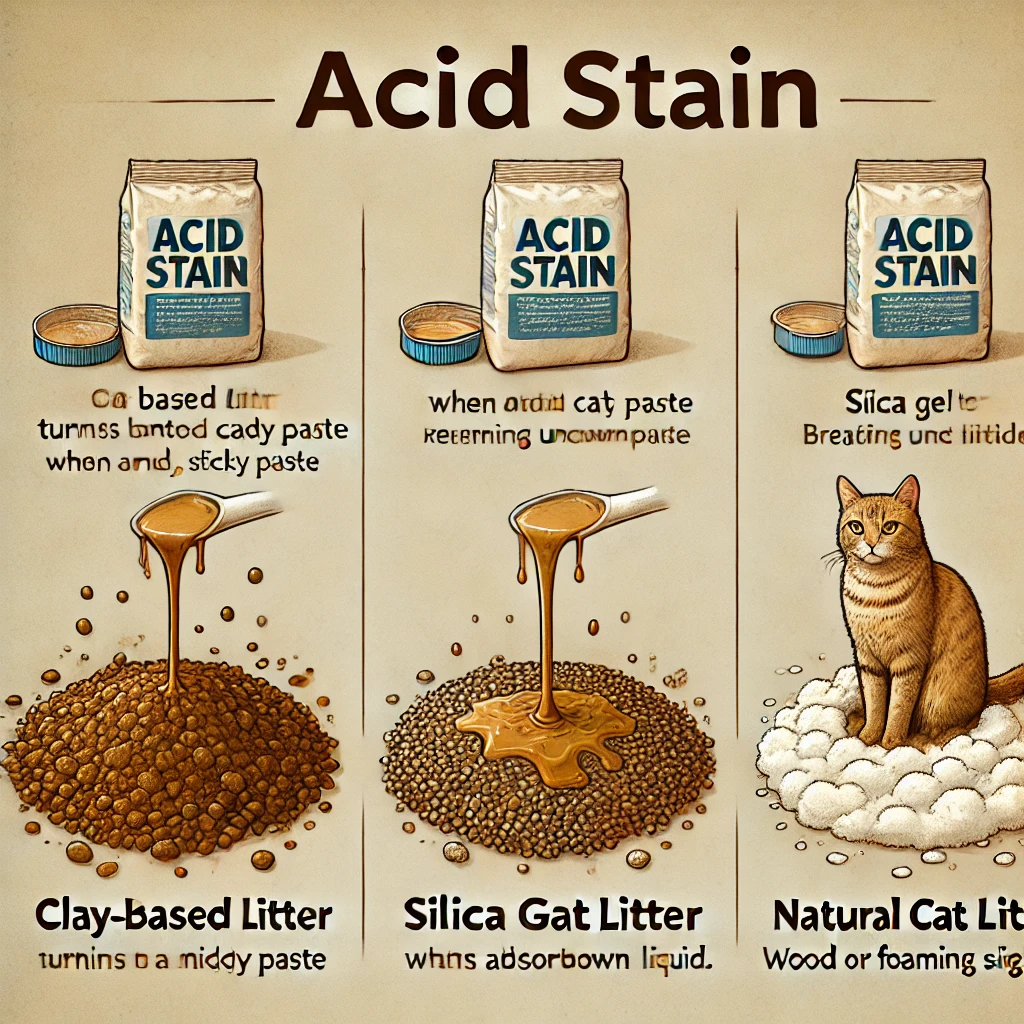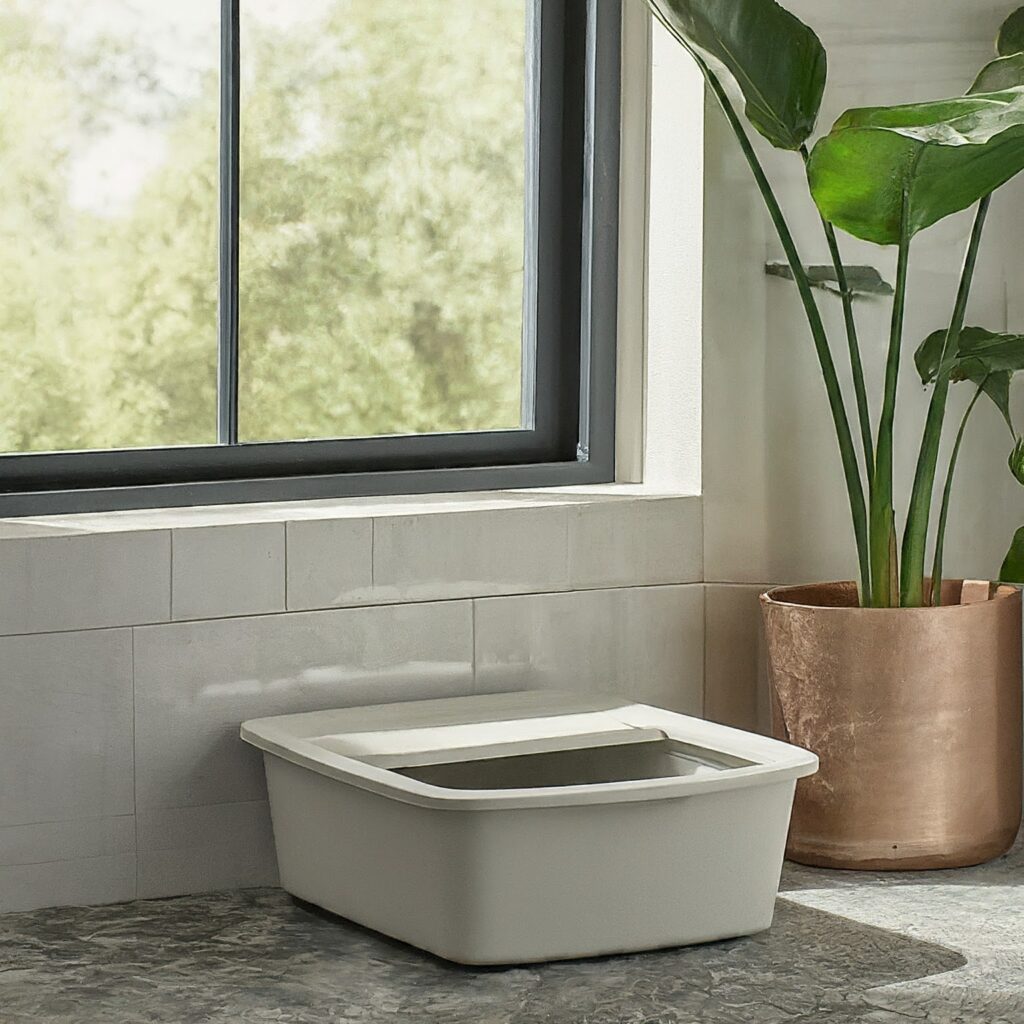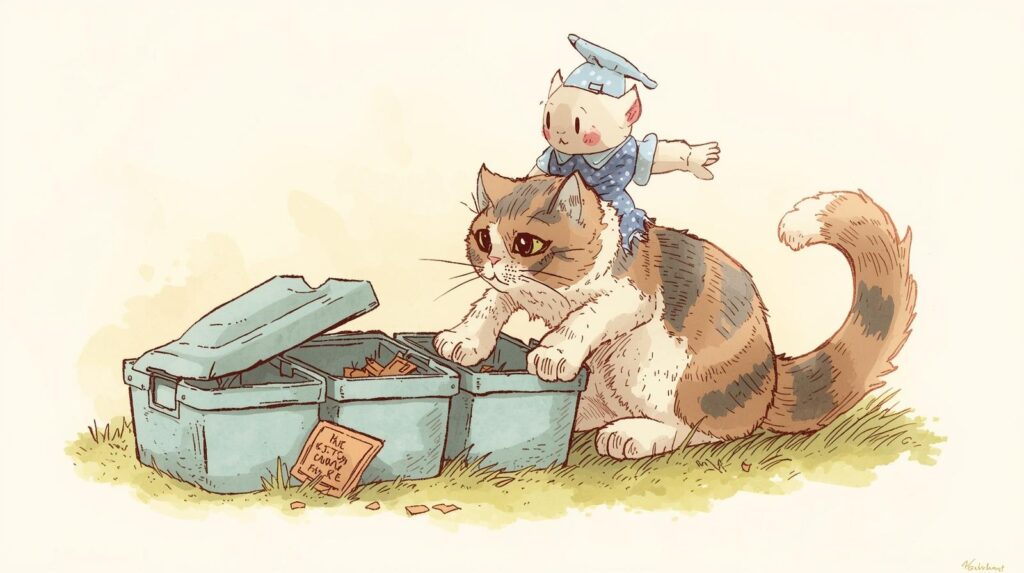When discussing the interaction between acid stains and cat litter, it’s essential to explore both the chemical properties involved and the practical implications for pet owners. This blog will cover the chemistry behind these interactions, the types of cat litter available, and how to manage odors effectively while ensuring the safety of your pets.

Table of Contents
Does acid stain react to cat litter?
Yes, an acid stain can react with cat litter, particularly if the litter is made from clay-based materials, as the clay can absorb the acid and potentially change color or texture depending on the concentration of the acid and the type of stain used; this is because cat urine contains a small amount of acid, which is why some specialized cat litters can change color when exposed to it.
What is an Acid Stain?
Acid stain is a chemical solution used to color concrete surfaces. It contains a mix of:
- Water
- Mineral salts
- Hydrochloric or phosphoric acid
The acid reacts with the lime content in concrete, creating a permanent color effect that doesn’t chip or peel like paint.
What is Cat Litter Made Of?
Cat litter comes in different types, but the most common are:
- Clay-based (Bentonite) – Absorbs moisture and clumps
- Silica gel – Highly absorbent, used for moisture control
- Natural materials (wood, paper, corn, wheat, or diatomaceous earth) – Eco-friendly but less absorbent than clay
Each type reacts differently when exposed to acidic substances like acid stain.
The Chemistry Behind Acid Stains and Cat Litter
Acid stains are primarily used in concrete finishing to create a decorative effect by reacting with the minerals in the concrete. These stains typically contain acids that react with calcium carbonate and other compounds, resulting in a permanent color change. However, the chemistry shifts significantly when considering cat litter, particularly those made from clay or silica.
- Types of Cat Litter:
- Clay-Based Litters: Most common types include sodium bentonite, which is known for its clumping ability. The dust from these litters can contain harmful chemicals that may pose health risks to both cats and humans.
- Silica Gel Litters: Made from amorphous silica gel, these litters absorb moisture and odors effectively. They work by adsorbing ammonium ions produced from urine breakdown, contributing to unpleasant smells3.
- Natural Litters: These are made from materials like corn or wheat and are often more environmentally friendly.
- Acidic Reactions:
- When acids (like citric acid) are introduced into cat litter, they can react with ammonia present in cat urine. This reaction can create non-volatile ammonium salts, which help neutralize odors1. However, excessive use of acidic substances could lead to potential toxicity if ingested by cats over time.
Managing Odors with Acidic Additives
Many pet owners seek ways to reduce odors emanating from litter boxes. A common suggestion is to mix citric acid or vinegar into the litter. Here’s how it works:
- Neutralizing Ammonia: Citric acid can react with ammonia in cat urine to form ammonium citrate, which is less odorous than ammonia itself. This method can be effective in removing ammonia smell but should be used cautiously.
- Safety Considerations: While citric acid is generally safe in small amounts, overuse can lead to health issues for pets if they ingest too much litter treated with acidic substances1.
Can You Use Cat Litter to Clean Up Acid Stain Spills?
Yes, cat litter can be used to absorb spilled acid stain, but with precautions:
- Clay-based litter works best for absorbing liquid spills.
- Avoid stirring the litter too much—it can become a muddy mess.
- Neutralize the acid with baking soda or ammonia after absorbing it.
- Dispose of used cat litter properly, as it contains acidic residue.
How to Clean Acid Stain with Cat Litter:
- Sprinkle cat litter over the acid stain spill.
- Let it sit for 10-15 minutes to absorb the liquid.
- Carefully scoop up the litter and dispose of it.
- Neutralize the area with a baking soda and water mixture.
- Rinse with clean water to remove any residue.
Can Cat Litter Be Used in Concrete Staining?
Some DIYers and professionals experiment with adding cat litter to concrete for texture or absorbing excess moisture. However:
- Clay litter can weaken concrete by making it brittle.
- Silica-based litter does not react with the acid stain and may not affect color.
- Organic litter may decompose, affecting the integrity of the stain over time.
Better Alternatives to Cat Litter in Concrete Staining:
- Sawdust – Absorbs excess stain and is easy to clean.
- Sand – Helps with slip resistance and texture.
- Baking soda – Neutralizes acidic residue.
- Kitty litter (only for cleanup) – Avoid mixing it directly into concrete.
Best Practices for Using Acidic Additives
If you choose to use acidic additives in your cat litter, consider the following best practices:
- Moderation: Use small amounts of citric acid (e.g., one part acid to four parts litter) to minimize any potential health risks while still achieving odor control.
- Mix Thoroughly: Ensure that any additive is mixed thoroughly with the litter to avoid concentrated areas that could be harmful if ingested.
- Monitor Your Pet: Keep an eye on your cat’s behavior after introducing any new substances into their environment. If you notice any adverse reactions (e.g., avoidance of the litter box), discontinue use immediately.
Conclusion
The interaction between acid stains and cat litter involves complex chemistry that can be utilized for effective odor management.
While acidic additives like citric acid can help neutralize ammonia odors, they must be used judiciously to ensure the safety of your feline companions. Understanding these chemical reactions not only aids in maintaining a pleasant home environment but also promotes responsible pet ownership.


